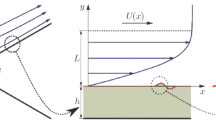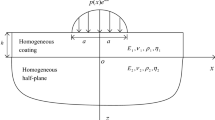Abstract
This paper formulates the problem of determining the response of a flat monolithic viscoelastic coating to traveling pressure and shear waves in two-dimensional formulation. Examples of corresponding numerical computations for coating parameters typical for laboratory experiments on the reduction in turbulent viscous drag are presented. The coating parameters are demonstrated, which provide the setting time less than one period of the forced oscillations. It is shown that the time to reach the regime is practically the same for both the shear and the pressure forcing, the time being increased with a decrease in relative thickness of the coating, as well as with an increase in the forcing frequency, particularly at frequencies above the first resonance frequency.




Similar content being viewed by others
References
Kramer, M.O.: Boundary layer stabilization by distributed damping. J. Am. Soc. Naval Eng. 72(1), 25–34 (1960). https://doi.org/10.1111/j.1559-3584.1960.tb02356.x
Yu, H.-Y., Zhang, H.-C., Guo, Y.-Y., Tan, H.-P., Li, Y., Gong-Nan, X.: Thermodynamic analysis of shark skin texture surfaces for microchannel flow. Contin. Mech. Thermodyn. 28, 1361–1371 (2016). https://doi.org/10.1007/s00161-015-0479-5
Kramer, M.O.: The dolphins’ secret. J. Am. Soc. Naval Eng. 73(1), 103–108 (1961). https://doi.org/10.1111/j.1559-3584.1961.tb02422.x
Carpenter, P.W., Garrad, A.D.: The hydrodynamic stability of flow over Kramer-type compliant surfaces. Part 1. Tollmien–Schlichting instabilities. J. Fluid Mech. 155, 465–510 (1985). https://doi.org/10.1017/S0022112085001902
Carpenter, P.W., Lucey, A.D., Dixon, A.E.: The optimisation of compliant walls for drag reduction. In: Choi, K.-S. (ed.) Recent Developments in Turbulence Management, pp. 195–221. Springer, Berlin (1991). https://doi.org/10.1007/978-94-011-3526-9_11
Kulik, V.M., Poguda, I.S., Semenov, B.N.: Experimental investigation of one-layer viscoelastic coating action on turbulent friction and wall pressure fluctuations. In: Choi, K.-S. (ed.) Recent Developments in Turbulence Management, pp. 263–289. Kluwer Academic Publishers, Dordrecht (1991). https://doi.org/10.1007/978-94-011-3526-9
Enakoutsa, K., Della Corte, A., Giorgio, I.: A model for elastic flexoelectric materials including strain gradient effects. Math. Mech. Solids 21(2), 67–84 (2016). https://doi.org/10.1177/1081286515588638
Turco, E., Barchiesi, E., dell’Isola, F.: A numerical investigation on impulse-induced nonlinear longitudinal waves in pantographic beams. Math. Mech. Solids 27(1), 1–27 (2021). https://doi.org/10.1177/10812865211010877
Benjamin, T.B.: The threefold classification of unstable disturbances in flexible surfaces bounding inviscid flows. J. Fluid Mech. 16(3), 436–450 (1963). https://doi.org/10.1017/S0022112063000884
Duncan, J.H., Waxman, A.M., Tulin, M.P.: The dynamics of waves at the interface between a viscoelastic coating and a fluid flow. J. Fluid Mech. 158, 177–197 (1985). https://doi.org/10.1017/S0022112085002609
Duncan, J.H.: The response of an incompressible, viscoelastic coating to pressure fluctuations in a turbulent boundary layer. J. Fluid Mech. 171, 339–363 (1986). https://doi.org/10.1017/S0022112086001477
Semenov, B.N., Semenova, A.V.: Recent developments in interference analysis of compliant boundary action on near-wall turbulence. In: Proceedings of the International Symposium on Seawater Drag Reduction, Newport, RI, pp. 189–195 (1998)
Lee, T., Fisher, M., Schwarz, W.H.: Investigation of the stable interaction of a passive compliant surface with a turbulent boundary layer. J. Fluid Mech. 257, 373–401 (1993). https://doi.org/10.1017/S002211209300312X
Choi, K.-S., Yang, X., Clayton, B.R., Glover, E.J., Atlar, M., Semenov, B.N., Kulik, V.M.: Turbulent drag reduction using compliant surfaces. Proc. R. Soc. A Math. Phys. Eng. Sci. 453, 2229–2240 (1997). https://doi.org/10.1098/rspa.1997.0119
Kulik, V.M.: Method of measurement of vibration parameters of a real dolphin skin. In: Nachtigall, W., Wisser, A. (eds.) BIONA-Report 12, pp. 225–227. Gustav Fischer Verlag, Stuttgart (1998)
Semenov, B.N.: Analysis of four types of viscoelastic coatings for turbulent drag reduction. In: Emerging Techniques in Drag Reduction, pp. 187–206. Wiley, London (1996)
Boiko, A.V., Kulik, V.M., Seoudi, B.M., Chun, H.H., Lee, I.: Measurement method of complex viscoelastic material properties. Int. J. Solids Struct. 47(3–4), 374–382 (2010). https://doi.org/10.1016/j.ijsolstr.2009.09.037
Abd-alla, A., Giorgio, I., Galantucci, L., Hamdan, M., Del Vescovo, D.: Wave reflection at a free interface in an anisotropic pyroelectric medium with nonclassical thermoelasticity. Contin. Mech. Thermodyn. 28, 1–13 (2016). https://doi.org/10.1007/s00161-014-0400-7
Xia, Q.-J., Huang, W.X., Xu, C.-X.: Direct numerical simulation of turbulent boundary layer over a compliant wall. J. Fluids Struct. 71, 126–142 (2017). https://doi.org/10.1016/j.jfluidstructs.2017.03.005
Xia, Q.-J., Huang, W.-X., Xu, C.-X.: Direct numerical simulation of a turbulent boundary layer over an anisotropic compliant wall. Acta. Mech. Sin. 35(2), 384–400 (2019). https://doi.org/10.1007/s10409-018-0820-x
Lee, I., Chun, H.H., Kim, J.: The transient response characteristics of compliant coating to pressure fluctuations. J. Mech. Sci. Technol. (KSME Int. J.) 20(4), 533–544 (2006)
Landau, L.D., Lifshitz, E.M.: Fluid Mechanics, Secnd Pergamont Press, Oxford (1987)
Lemaitre, J. (ed.): Handbook of Materials Behavior Models. Academic Press, San Diego (2001)
Fung, Y.C.: Foundations of Solid Mechanics. Prentice Hall, Englewood Cliffs (1965)
Kulik, V.M.: Forced oscillations of a layer of a viscoelastic material under the action of a convective pressure wave. J. Appl. Mech. Tech. Phys. 48(2), 221–228 (2007). https://doi.org/10.1007/s10808-007-0029-4
Canuto, C., Hussaini, M.Y., Quarteroni, A., Zang, T.A.: Spectral Methods: Fundamentals in Single Domains. Springer, Berlin (2006). https://doi.org/10.1007/978-3-540-30726-6
Shampine, L.F., Reichelt, M.W., Kierzenka, J.A.: Solving index-1 DAEs in MATLAB and Simulink. SIAM Rev. 41(3), 538–552 (1999). https://doi.org/10.1137/S003614459933425X
Kulik, V.M., Semenov, B.N., Boiko, A.V., Seoudi, B.M., Chun, H.H., Lee, I.: Measurement of dynamic properties of viscoelastic materials. Exp. Mech. 49(3), 417–425 (2009). https://doi.org/10.1007/s11340-008-9165-x
Kulik, V.M., Boiko, A.V., Bardakhanov, S.P., Park, H., Chun, H.H., Lee, I.: Viscoelastic properties of silicone rubber with admixture of SiO\(_{2}\) nanoparticles. Mater. Sci. Eng. A 528(18), 5729–5732 (2011). https://doi.org/10.1016/j.msea.2011.04.021
Kulik, V.M., Boiko, A.V., Lee, I.: Drag reduction by compliant coatings made of a homogeneous material. Thermophys. Aeromech. 25(4), 537–546 (2018). https://doi.org/10.1134/S0869864318040054
Kulik, V.M., Boiko, A.V., Lee, I.: Using two-layer compliant coatings to control turbulent boundary layer. Thermophys. Aeromech. 26(1), 47–57 (2019). https://doi.org/10.1134/S0869864319010056
Benjamin, T.B.: Shearing flow over a wavy boundary. J. Fluid Mech. 6(2), 161–205 (1959). https://doi.org/10.1017/S0022112059000568
Boiko, A.V., Kulik, V.M.: Stability of flat plate boundary layer over monolithic viscoelastic coatings. Dokl. Phys. 57(7), 285–287 (2012). https://doi.org/10.1134/S1028335812070051
Kulik, V.M.: Action of a turbulent flow on a hard compliant coating. Int. J. Heat Fluid Flow 33(1), 232–241 (2012). https://doi.org/10.1016/j.ijheatfluidflow.2011.10.003
Weideman, J.A.C., Reddy, S.C.: A MATLAB differentiation matrix suite. ACM Trans. Math. Softw. 26(4), 465–519 (2000). https://doi.org/10.1145/365723.365727
Funding
The work was supported by the Moscow Center of Fundamental and Applied Mathematics at INM RAS (Agreement with the Ministry of Education and Science of the Russian Federation No.075-15-2022-286).
Author information
Authors and Affiliations
Corresponding author
Additional information
Communicated by Andreas Öchsner.
Publisher's Note
Springer Nature remains neutral with regard to jurisdictional claims in published maps and institutional affiliations.
Appendix: Spatial discretization
Appendix: Spatial discretization
We construct a nonuniform grid in \(0 \le y \le 1\) with nodes \(y_{j} = (x_{j}-1)/2\), \(j=0, \dots n+1\), where \(x_{j}\), \(j=1, \dots n\), are the roots of the derivatives of the Legendre polynomials of degree \(n+1\) and \(x_{0}=-1\) and \(x_{n+1}=1\) (Gauss–Lobatto nodes) [26]. Recall that \({\varvec{\xi }}\) and \({\varvec{\eta }}\) are the \(n+1\)—component vector columns containing, respectively, the values of the tangent and normal components of the displacement at all nodes \(y_{j}\), excluding the boundary node \(y=0\) due to the zero boundary conditions. In addition, let \(D_{y}\) and \(D_{yy}\) be the square matrices of order \(n+2\), which are discrete analogs of the first and second derivative operators on y at nodes \(y_{j}\), \(j=0, \dots n+1\), respectively. We compute these matrices using the algorithms described in [35]. Given the zero boundary conditions for the displacement components at node \(y_{0}=0\), we discard the first column and the first row in \(D_{y}\). In the resulting matrix, denote the first n rows by \(D_{1}\), and the last one by \(d_{1}\). Similarly, we obtain a matrix \(D_{2}\) based on \(D_{yy}\). The matrices \(D_{1}\) and \(D_{2}\) of size \(n \times n+1\) are the discrete analogs of the first and second derivative operators at nodes \(y_{j}\), \(j=1, \dots n\), respectively, for the displacements given at nodes \(j=1, \dots n+1\), and the \(n+1\)-element row \(d_{1}\) is a discrete analogue of the first derivative operator at node \(y_{n+1}=1\) for displacements given at nodes \(j=1, \dots n+1\).
Using the differentiation matrices, the spatially approximated equations (13) can be written as follows:
where \(\hat{I}\) is the matrix obtained from the identity matrix of order \(n+1\) after discarding its last row, \(c_{lt} = c_{l}^{2}-c_{t}^{2}\), and \(L_{tl} = c_{t}^{2} D_{2} - k^{2} c_{l}^{2} \hat{I}\) and \(L_{lt} = c_{l}^{2} D_{2} - k^{2} c_{t}^{2} \hat{I}\). For the boundary conditions (15) at \(y=1\), we have:
where \(i_{1}\) is the last row of the identity matrix of order \(n+1\).
Thus, Eqs. (13) approximated in space, taking into account the boundary conditions (14), (15), can be written as system (19) with matrices
Rights and permissions
Springer Nature or its licensor holds exclusive rights to this article under a publishing agreement with the author(s) or other rightsholder(s); author self-archiving of the accepted manuscript version of this article is solely governed by the terms of such publishing agreement and applicable law.
About this article
Cite this article
Boiko, A.V., Demyanko, K.V. & Kulik, V.M. Setting of forced oscillations of viscoelastic coating. Continuum Mech. Thermodyn. 35, 1343–1352 (2023). https://doi.org/10.1007/s00161-022-01133-4
Received:
Accepted:
Published:
Issue Date:
DOI: https://doi.org/10.1007/s00161-022-01133-4




